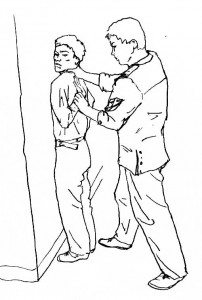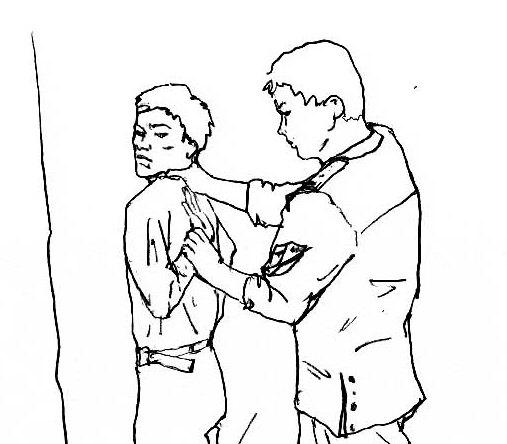Unfortunately, it’s common practice today to try to coerce addicts into quitting their substance use habits, and this brings several overlooked consequences, not the least of which is a failure to achieve the desired result of sobriety, and a more insidiously hidden devastating long-term effect I call The Twisted Arm Error.
 To twist someone’s arm is to coerce them into doing something. There is a growing occupation built around arm-twisting in the addiction rehab industry: that of the interventionist. The interventionist is an expert in coercion. They’re great at what they do, which is to get a substance user to submit to a family’s wishes to undergo addiction treatment.
To twist someone’s arm is to coerce them into doing something. There is a growing occupation built around arm-twisting in the addiction rehab industry: that of the interventionist. The interventionist is an expert in coercion. They’re great at what they do, which is to get a substance user to submit to a family’s wishes to undergo addiction treatment.
Note that the interventionist doesn’t necessarily coerce people into changing their habits – they simply specialize in coercing them to attend a treatment program. The process is well documented on A&E’s reality television show ‘Intervention’.
Typically, the interventionist meets with the family first and trains them to deliver ultimatums which include withdrawing love, shelter, and monetary support. They also focus on inducing guilt, by having the family write letters outlining all the ways they’ve been wronged and emotionally hurt by the substance user. The substance user is then ambushed by the family and the interventionist in a meeting where the dramatic letters are read aloud for all to hear, ultimatums are delivered, and the substance user is pressured into shuffling off to a rehab facility.
The process works quite well at achieving it’s goal: coercing the substance user to go to rehab. However, there is no telling whether the substance user has made the choice to change their goals and behavior. Often, by the end of the intervention they’ve only really agreed to go to rehab – and they’re making this choice not out of a careful examination of their true desires for life or a weighing of the costs and benefits of their habit – but rather they’re making the choice because their arm has been twisted, they don’t want to endure further humiliation and guilt, and they’re ready to appease their family by going through the motions of entering a rehab. In other words, the attempt at sobriety you’ve caused with the intervention is insincere on the part of the substance user – it’s an act of mere appeasement.
The result is that the trip to rehab is often a failure. The substance user resumes use when they get out, and they resolve to do a better job of hiding their habits this time around.
After their first trip to rehab though, they’ve got a new trick up their sleeve when they get caught again: the incurable disease. They now have a convenient excuse for their choices about substance use. They can go right back to a problematic pattern of use and blame it on the nature of their disease. You’ll likely nag them to get more treatment, twist their arm some more, and they’ll go back only to fail again and end up even worse off than before they ever received any treatment at all. This cycle often repeats several times – and this is where the longer term error begins.
The Twisted Arm Error in Action
As an outsider, you see your substance user as someone who has received many rounds of failed medical treatment, and you begin to get completely hopeless. You start to believe that he’ll never change. It begins to sink in that these people are probably correct – your loved one has an incurable disease which he must battle for the rest of his life! After all, he’s gotten 5 rounds of treatment and it hasn’t done an ounce of good – he only seemed to stay sober while he was actually in rehab (when he was actively appeasing you).
The error has its foundation in a fundamental misunderstanding of addiction. If addiction were a true disease, then you could coerce someone into treatment, and it would work – like if you forced someone to swallow an antibiotic. However, addiction is really nothing more than a pattern of choices where the substance user is simply choosing to do the thing that they believe will bring them the most happiness at this moment in life. Failing to recognize this fact, the evidence of repeated failures confirms the disease theory and the need for ongoing episodes of treatment.
What must be recognized is that your loved one hasn’t failed. They’ve sought to appease you – to stop the arm-twisting – and in this goal, they’ve succeeded. They haven’t actually tried to explore alternative behaviors to substance use – they haven’t tried to make new choices – thus they’ve never really failed at making new choices about substance use. So their failure is an illusion. The belief that they’ve failed is an illusion – the belief that their “disease” is strong is also an illusion – it’s all a massive error in judgment based on an inaccurate view of the situation. It creates hopelessness, causes families to invest everything in neverending cycles of treatment, and to accept that their loved one is truly hopeless. This is the destruction wrought by The Twisted Arm Error.
If there’s one thing the recovery culture has gotten right it’s the idea that for someone to change their substance use habit, by any means, “they have to want it.” If addiction were a disease, then wanting a cure wouldn’t matter so much. “Wanting it” only matters because addiction is a choice. The really tragic part comes in when the substance user finally “wants it.”
Hope Destroyed by The Twisted Arm Error
By the time the substance user finally realizes that their habit isn’t providing the kind of happiness they want out of life, and they finally end up wanting to change, they may have fallen victim to the Twisted Arm Error themselves – making their plight that much more difficult.
At this point, they make a real effort to get help, and head off to rehab for the sixth time. They’re sincere now, they’re not simply doing this to get people off their back or escape nagging – their not appeasing anyone but rather truly trying to change their habit and improve their life. But what was once a simple choice now doesn’t appear so simple.
The following circumstances converge to form a huge roadblock to successful change:
- Their 5 previous “failures” in rehab
- The fact that these rehab stints were the only times they’ve been sober in recent years
- The myths of disease and powerlessness that they’ve been taught
With all of this under their belt, the substance user also falls prey to The Twisted Arm Error. They think to themselves “this isn’t easy, I’ve tried it 5 times before. I’ll probably fall flat on my face when I get out of rehab.” Meanwhile, the truth they don’t realize is that they never really tried, and they never really made a self-driven choice about changing their habit before. Their previous attempts at quitting were all done under duress – they were all done to stop their arm from being twisted.
Failing to recognize this though, the Twisted Arm Error takes hold, and convinces the substance user that their problem is much bigger and harder to solve than it actually is. This is a rough state of affairs – these are the saddest cases to watch, because they truly want to change, and nothing but an illusion or boogeyman is holding them back from success.
The View From The Inside
Counselors and other treatment professionals remain painfully unaware of the Twisted Arm Error. I recently wrote about a related error, The Clinician’s Illusion, in which rehab workers base their opinions of addiction on the clients they spend the most time with – rather than seeing the full picture of those who quit problematic substance use without any formal help, or even those who quit after a brief period of help. The minority of the worst cases set the standard for how all substance users are misunderstood and mistreated.
This Clinician’s Illusion is closely related to The Twisted Arm Error. An appeasing substance user such as the one described above, is just the type of client that these professionals may spend the most time with – and now the very things these counselors have taught them in the past (that they have an incurable disease, and that they’re powerless over drugs and alcohol) are setting them up for present day failures. These ideas have robbed the substance user of the confidence and self-efficacy so necessary for change.
This substance user’s past insincere stints in rehab, as well as their new botched attempts to change only serve to reinforce the counselor’s faulty opinion that ongoing treatment is necessary. This error leads to the conclusion that longer stays in rehab are better, that ongoing outpatient and “aftercare” is necessary, and that lifelong involvement in 12-step groups is imperative. None of it was ever necessary. If these professionals had taught the truth that substance use is a choice, then although the substance user was only appeasing their family when they first sought help, they would be prepared to change when they actually wanted to – instead, they’re powerless now (because they believe they are). Moreover, if the counselors had presented them with an honest discussion about exploring options to substance use – the substance user might have gotten to the point of making a sincere change sooner. Unfortunately for all involved, the faulty disease and powerlessness theories have tainted the whole process and underly a massive web of self-confirming errors which may forever mislead and prolong the misery of people with substance use problems and those who want to help them.
In A Nutshell
The Twisted Arm Error is a phenomenon whereby failure in coerced attempts at addiction treatment confirm the notion that addiction is an incurable disease which requires ongoing cycles of treatment and a lifelong effort at “recovery.”

Great analysis of the problem, Steve. The following is probably the most important observation you made in this article: “They haven’t actually tried to explore alternative behaviors to substance use – they haven’t tried to make new choices – thus they’ve never really failed at making new choices about substance use. So their failure is an illusion.” This is so important for both the substance user and the family to understand.